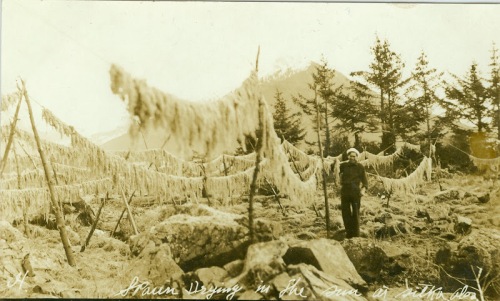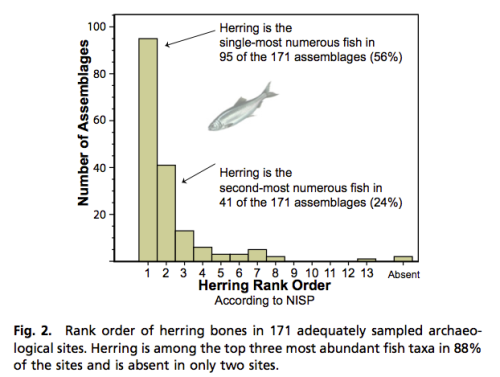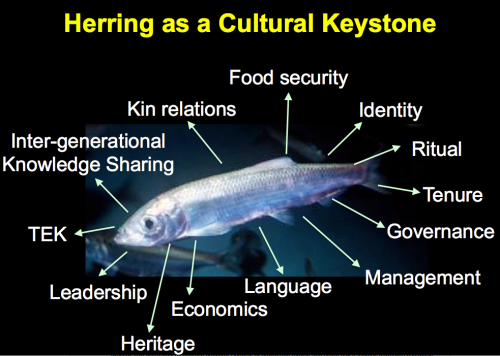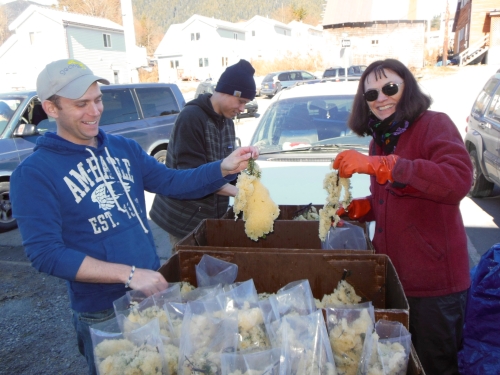
Herring “spawn drying in the sun near Sitka Alaska”, ca. 1900. Source: Sealaska Heritage Institute, Richard Wood Collection. http://goo.gl/y8NF2h
Herring are taking Northwest Coast archaeology by storm. A series of key insights and publications has pulled these little fish into the heart of our reconstructions of subsistence – across the entire coast, and into its deepest history. It’s an interesting development which highlights once again how prone archaeologists can be to a myopic faith in our received models: salmon and cedar speak the loudest and it turns out we needed an aid in hearing herring.
Herring were valued in two very different ways: as delicious food in their own right, and for their eggs, which they would spawn in prodigious numbers in the nearshore, often on kelp or on conifer branches, which could even be placed in the water by people for this purpose. The spawn fishery would leave little or no durable archaeological evidence, and perhaps has been correspondingly underestimated by local researchers. Eating the fish themselves has left a widespread, robust record, yet one which has also been underestimated. All this by way of introducing the picture above, which I haven’t seen reproduced elsewhere, showing gobs of dried herring spawn near Sitka, Alaska. It’s from the excellent online photo archives of the Sealaska Heritage Institute. Each of those clumps is like a rich, nutrient-dense, yet storable, delicious marine omelet.
The emerging archaeology of herring is too big a topic for a mere blog to cover, but click onwards for a couple more comments and links.

Herring is top three ranked at 88% of NW Coast sites. Source: McKechnie et al. 2014 PNAS. http://www.pnas.org/content/111/9/E807.full.pdf+html?with-ds=yes
As George Orwell said, “To see what is in front of one’s nose needs a constant struggle.” The recent paper by McKechnie et al (2014) really shows clearly how front and centre herring are, or should be, in the Northwest archaeological record. Not only are they ubiquitous (found in some numbers at almost every archaeological site), but they rank highly by the most simple counting method: number of identified bones. As the graph above shows, they’re in the top three fish at 88% of a very large sample of 171 sites, and the top two at 80%. The paper is now open access so you can download it to see the other excellent figures which (spoiler alert) show herring in every nook and cranny, usually in disgustingly large amounts. Now, no doubt at certain times and places other species hold sway, but we can’t ignore the important role of herring, no matter where on the NW Coast we work, and especially in the Salish Sea. I should give a shout-out as well to Greg Monks, who was ahead of the curve in this regard with his provocative 1987 “prey as bait” hypothesis, in which herring, mass harvested in traps, played a central role in combating what he saw as “salmonopeia”, a perceptual disease thought to be chronic among local archaeologists.

Slide from Dana Lepofsky slideshow “Herring as a cultural keystone; archaeology, anthropology & genetics, policy & governance”, available with other herring resources here: http://www.sfu.ca/hakai/current-research-programs/herring-school/-advancing-ecosystem-based-management-of-low-trophic-level-fishe.html
Another interesting aspect of the herring story is rooted in historical ecology. Herring have been heavily impacted by historic fishing practices, many of the rapacious mine-the-sea mentality. Even the massive runs of historic times may pale to those of the more distant past. As a keystone forage-fish, herring may underpin the resilience of the North Pacific foodweb and consequently, we may be severely underestimating the potential productivity of the entire ecosystem if we accept herring-depleted recent conditions as a baseline. Luckily, there is an active program to really pin down the productivity and importance of herring from biological, cultural and archaeological perspectives. As with so many of the cutting-edge marine science programs here on the coast, the “Herring School” is underwritten by the Tula Foundation / Hakai Institute. They have an absolutely gorgeous web site, most notably several dozen short videos which explain the importance of herring to coastal people and scientists. Kudos to Dana Lepofsky, Anne Saloman, Iain McKechnie, Margot Hessing-Lewis, Madonna Moss, Alisha Gauvreau, Mark Wunsch and the school of others (I knew I shouldn’t have started naming names!) involved in bringing herring to the forefront of archaeology and conservation biology. I should also add the backbone of the McKechnie et al. research is the careful faunal work done by numerous individuals over the years, but most prominently perhaps by Susan Crockford, Becky Wigen and Gay Frederick at Pacific Identifications. Anyway, it’s exciting to see archaeology at the forefront of such an important issue in the economic and social life of the present day.

Madonna Moss in Alaska with herring roe on confer branches. Source: Madonna’s blog, http://blogs.uoregon.edu/mmoss/
Speaking of Madonna Moss, you can get a really excellent introduction to herring in Northwest Coast archaeology by listening to her hour-long illustrated lecture to the SHI from earlier this year. It includes not only a lot of knowledge but key references are given and it’s an excellent primer on the subject. There’s also a great introductory article by the indispensable Jude Isabella.
So herring: why so hard to hear? I suspect “salmonopeia” still has something to do with it. For example, if we stereotype all fish traps as being directed towards salmon, we miss the labour investment that went into harvesting herring and downgrade it accordingly. If we interpret bones points as fish hook barbs and not herring rake tines, we underestimate herring. Of course, herring are small fish with small bones, and you need to be fairly dedicated to fine-mesh water-screening to feel confident you’re getting the herring, or enough of them – or you must be quite thorough in your column sampling. It’s even more impressive that they are so common and ubiquitous in the face of a perhaps patchy record of half-hearted recovery efforts. I posted before about eulachon, an “archaeologically invisible” food because of the extreme processing methods needed to render out their oil. Herring are not as intrinsically silent as that — while the roe which triggered this blog post is archaeologically invisible, the bones, though small, are durable– but they have been seriously under-estimated. Not, perhaps, because we’ve been incapable of hearing their signal but because we’ve been unready or unwilling or ill-disposed towards doing so. Probably the same holds for eulachon, which spawn in prodigious, concentrated schools of millions. For me, reconfiguring my own template of NW Coast subsistence is going to take some effort, and perhaps a slap in the head with a cold kipper before I truly get it – but it’s coming and very surely, we’re all going to get schooled by herring.



Looking at the topmost picture of herring spawn, it’s also interesting to see where the racks are set up. It looks like a bare boulder field, possibly uppermost intertidal? Or one of those mossy/licheny areas where trees just can’t seem to get going. But note how cleverly some of the drying rack poles are singletons, jammed in between boulders to form sturdy uprights. Another example of intense use of an area that later we would probably call “low potential” for archaeological findings.
I also did a complete guesstimate of the amount of herring spawn on display in the picture (and you can see the racks extend out of frame) and I came up with about 175 kg of spawn. Switching from back of envelope to table napkin, that’ equivalent to about 250 dozen large size chicken eggs, or 3,000 eggs, about the annual output of keeping 9 domestic chickens.
BTW, I learned this kind of calculation from twoeyes’ quantification of fish in the Webber image of the house interior at Yuquot.
LikeLike
This is very strange. I had no idea that modern archaeologist is so very ignorant of the importance of herring in the maritime societies of Alaska. Gifts of herring eggs on spruce boughs have been received as gifts from SE Alaska harvesters since the 1980’s. However this is followed by herring eggs from my wife’s relatives on Nelson Island on the Bering Sea coast.. The Central Yupik catch enormous amounts of Herring from 3 separate runs in May and early June. They call themselves the Qalukamuit or people of the dip net., The dip net was the primary tool for catching smelt, and herring. The herring are sewn together with strands of rye grass and dried on tripod racks. Those that fail to dry and begin to ferment are plucked off the strands and put into a seal skin poke. The 2 inches of fat on the seal is left in the poke. It is sewn up tight and left on the floor of the cache house for up to a year or until an event requires a delicacy. The dried herring is stored in grass baskets or in buckets or pokes of seal oil. Today buckets of fresh herring eggs and sea weed are stored in the freezer. Eggs taken from herring are dried and constitute and iron ration carried by hunter along with a container of seal oil. Families often process up to 2 or 3 thousand pounds of Herring. Herring are easy to process and their oil is quite stable. My wife was from Newtok, just NW of Nelson Island. Her father’s herring camps were on Nelson Island. Her people caught large amounts of herring but also captured huge amounts of northern pike and white fish. These fish were both dried and fermented. Nearby Hazen Bay and Cape Vancouver waters provided large amounts of halibut and flounders and these were either baked, boiled or dried Cod were formerly important but destroyed by factory vessels in the 1950’s. This s an extremely rich food area and the bearded seal is culturally the most important game animal, but herring, pike and other abundant salt and fresh water fish actually are the true staff of life in this region. My freezer contains many wonderful gifts of dried and delicious fermented fish.
LikeLike
Hi Richard, thanks for your vivid post!
I think it’s not so much that archaeologists didn’t know about herring, and it’s uses, and so forth, but that we didn’t weight it strongly enough in our mental models. As a result, interpretation suffered (technologies like some fish traps were not by default assigned to the herring industry) and in a vicious circle, recovery techniques necessary to find the evidence of the scale of herring were not applied. It’s something like plant resources – we “know” they’re important, yet somehow can’t crack through the routine steps needed to recover evidence of them.
I don’t want to trivialize the gender issue, but it’s sort of like how the past is by default male, and if you want to say that women did something in the past, you’re supposed to come up with some real evidence for it (pink artifacts, maybe), whereas if you just don’t say anything, the implication is male. Well on the NW Coast, the default is salmon, and primacy of other resources have to crawl themselves out of the salmon gravity well first.
As Madonna Moss points out in relation to clams, there may be a feedback loop between archaeologists and ethnographers as well. Ethnographers asking about clams were told they were “lazy peoples food” even as their shells achieved monumentality in their own right. In reverse, salmon may have been a highly-esteemed food so when asked by anthropologists, hey, what’s your top food, well, salmon is a natural answer. Sort of like I’d answer the same question with “roast lamb, 24/7” even while my garbage is bursting with ramen packages. So it’s in that setting that I welcome your account of herring usage!
LikeLike
I just finished the McKechnie et al. paper and wanted to point out how the Northwest Coast Archaeology Blog is a true resource for these kinds of cutting edge papers that I may not have easily found otherwise–thanks. I found the presentation brilliant since it may have answered part of how we get resource managers to pay attention to archaeological data!? I have for years pointed out to marine biologists doing research on bringing back the Olympia oyster in Puget Sound (as part of an overall effort to clean up Puget Sound….) that they should look to the archaeological record of this resource (and others), that we quantified by 5 cm layers in a number of ways, at the 700 BP
Qwu?gwes archaeological site in the deepest south of Puget Sound (https://www.dropbox.com/s/k21j3ymm6qffisn/2013%20The%20Qwugwes%20Archaeological%20Site%20Final%20Report.pdf?dl=0).
Researchers in our area have large projects at the U.W., W.S.U. and C.W.U. to work on the issue of Olympia oyster recovery, but rarely look to the archaeology to see what the resource was like over the centuries and ALSO our data (archaeological, oral histories and ethnographic) on how it was managed/sustained in the ancient past–a true reflection of long-term Native management knowledge.
So what McKechnie et al. have masterfully done is taken the industrial history of resource management data and show how it compared, and varied, from the millennium of archaeological data–no doubt making them pay attention! No doubt this is going to have an impact on their future work–requiring them to consider our growing data base on all these resources, both botanical (in expanding part because of wet site work) and zoological, and potentially asking and supporting us to do so in their future work. Thanks for sharing this important work.
P.S. Also appreciate getting acquainted with McKechnie’s blog with other valuable resources along this line linked (including his dissertation). Thanks, Dale
LikeLike
Dale — I think you got your clans mixed up – it was McKechnie not McLaren (I fixed it). We don’t need any clan hostilities rekindled out here.
Historical ecology and the relevance of archaeological data for management purposes has been recognized for quite a while – see Trevor Orchard’s work from (gasp) 15 years ago, for example.
But I think one thing that has changed more recently, and made this approach more effective, is that archaeologists and biologists (and others) are working together from the beginning on shaping each others’ projects. In the past, we might scream about the relevance of archaeological data, but no biologists could hear. Now with real interdisciplinary work happening (think of the Hakai Institute) we don’t have to fart into blizzards anymore, we can call biologists who we know are interested in the sorts of things archaeologists can speak to, and who are now familiar with the pros and cons of archaeological data.
LikeLike
Pingback: Around the Archaeology Blog-o-sphere Digest #9 | Doug's Archaeology
Quentin: CLOSE CALL–I actually have a linguistic disability when it comes to names–taking roll in classes was always torturous for me and students…..one good thing about semi-retirement. Probably the Mc- got me (indeed a clan issue).
I think Canada has done better in getting biologists and archaeologist to share notes, and a perfect example is the Hakai Institute and its truly interdisciplinary approach.
I bet if I work up some of the archeological data on Olympia oysters in Puget Sound and juxtapose it with the industrial take, this will help get their blizzard going! McKECHNIE et al. sets a good model to follow (have to be sure I don’t say McCutcheon (CWU)). My best to surfer Iain!
Thanks for Orchards and your work 15 years back–love the illustrations in that volume as I scanned through it–very inspirational.
Best, Dale McCroes
LikeLike
Dale and Richard, thanks from the team for those comments and great points and thanks to Quentin for bringing blogging light to this paper and the http://www.pacificherring.org/ website. Indeed, Becky Susan and Gay at Pacific ID provided much of the backbone to this dataset not to mention the positive influence the UVic Bone lab has had on fish bone identification generally.
LikeLike
Iain: I am also so glad that I have had Rebecca Wigen, Pacific ID/UVic, available to work on all vertebrate fauna and reports for all sites I was able to conduct since graduating in 1977 through 2013 (>35yrs….)–Hoko River wet site, Hoko Rockshelter, Sunken Village and Qwu?gwes. Certainly Pacific ID/UVic has the premier comparative fauna lab and fauna research team that we have available in the NW. Rebecca’s help in finalization of this work/reporting of these sites makes retirement feel good! Best, Dale
LikeLike
Iain:
“Backbone” – ha! Good one!
Congratulations to McKechnie And Al (et al) for all that “hilariously awesome sleuthing”. Who would have thought that counting all those tiny tiny would have paid off?
LikeLike